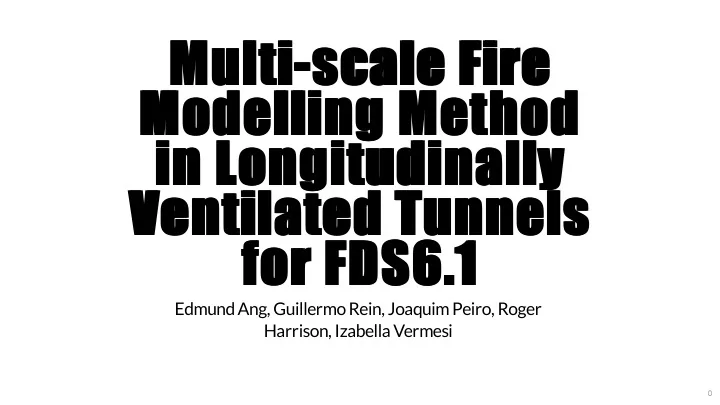

Multi-scale Fire Multi-scale Fire Modelling Method Modelling Method in Longitudinally in Longitudinally Ventilated Tunnels Ventilated Tunnels for FDS6.1 for FDS6.1 Edmund Ang, Guillermo Rein, Joaquim Peiro, Roger Harrison, Izabella Vermesi
Contents 1. Introduction 2. Multi-scale Modelling 3. Implementation of Multi-scale Modelling 4. Cold Flow Multi-scale Modelling Results 5. Multi-scale Fire Modelling Results 6. Conclusion 7. Reference
Introduction - Team Work carried out in 2014 Led by Edmund Ang (Imperial College London), with collaborators: Guillermo Rein (Imperial College London) Joaquin Peiro (Imperial College London) Roger Harrison (AECOM UK) Izabella Vermesi (Imperial College London) Special thanks to software support from Thunderhead Engineering
Introduction - Multi-scale Modelling Multi-scale modelling based on Colella et al [1] Previous work based on commercial CFD package and Reynolds Averaged Navier Stokes Multi-scale modelling using FDS6: Not attempted before Enabled by the FDS HVAC feature Proof of concept by Vermesi et al [2] Constant flow specified at boundary No coupling of jet fans to the fire behaviour
Multi-scale Modelling - What and Why Increasingly denser and taller buildings Scarcity of land resources High rise buildings Options for above ground rail or utility network limited Tunnel is often the more practical solution Tunnels can be used for rail, roads or utilities
Multi-scale Modelling - What and Why Ventilation is needed to most tunnels Life safety (fumes or CO from fire) Regulating temperature (train operation) Three main types of ventilation system Longitudinal (jet fans) Transverse (ducted supply and extract) Semi-transverse (hybrid of ducted and non-ducted)
Multi-scale Modelling - What and Why Figure 1. ECRL Rail Tunnel, Australia
Multi-scale Modelling - What and Why Design of tunnel ventilation system 1D / Subway Environment Simulation (SES) Early stages of design Fast computation Provides global averaged prediction Limitations on gas species or high resolution calculations
Multi-scale Modelling - What and Why 3D / Full CFD simulation To validate the design carried out at the earlier stages Time consuming Provides high resolution predictions, e.g. gas species and combustion Tunnel section models often shorten to reduce computational time Is there a best of both world?
Multi-scale Modelling - What and Why Multi-scale modelling method Using 1D for far field tunnel sections Full CFD for near field, or tunnel section of interest Significantly reduce the computational time Off-set computational time for longer tunnel section
Multi-scale Modelling - What and Why Multi-scale modelling method Direct and indirect coupling methods FDS6.1 is based on indirect coupling method Implemented using HVAC feature Acknowledge this is not the intended use of HVAC
Multi-scale Modelling - Implementation Model is based on Dartford Tunnel West Cold flow field measurement data available [1] Dartford Tunnel West properties: 1.5 km long 14 jet fans pairs (JFP) with 8.3 m3/s per fan Key of multi-scale model Interface between 1D and full CFD sections Flow need to be fully developed
Multi-scale Modelling - Implementation Diagram Figure 2. Representation of multi-scale model
Multi-scale Modelling - Implementation Details Lp is length of portal = 50 m LJF,UP and LJF,DW are length up and downstream of jet fans = 35 m and 130 m respectively Lfire is length each side of fire = 170 m Calibrated from running multiple models
Cold Flow Modelling Results Cold flow modelling results presented separately in Tunnelling and Underground Space Technology [3] Good correlation from 80 m downwind of the jet fans Poorer correlation nearer to jet fans: Lack of detailed information of installed jet fans Difficulty to accurately model the jet fans No accurate measurement of tunnel walls' surface roughness
Cold Flow Modelling Results Figure 3. Average velocities measured in the tunnel [3]
Cold Flow Modelling Results Figure 4. Multi-scale model velocity profile downwind of jet fans [3]
Cold Flow Modelling Results Figure 5. Multi-scale model velocity profile downwind of jet fans [3]
Cold Flow Modelling Results Figure 6. Reduction in computational time for the multi-scale model
Multi-scale Fire Modelling Results Adapted from the same cold flow multi-scale model Introduction of a fire in the middle of the tunnel Three fire sizes considered, 35 MW, 55 MW and 75 MW Validation study conducted (Arup Tunnel case) Mass flow rate is the measured variable Interesting behaviour observed in the multi-scale model
Multi-scale Fire Modelling Results Oscillatory mass flow observed Mass flow rates in multi-scale models do not stabilise compared to the full CFD model It is yet to be determined if the oscillation is numerical Similar oscillation for velocity and temperature observed by Vermesi et al [2]
Multi-scale Fire Modelling Results Figure 7. Mass flow rates (35 MW) in the tunnel. Left: Mass flow in and out. Right: Mass flow along the tunnel.
Multi-scale Fire Modelling Results Figure 8. Mass flow rates (55 MW) in the tunnel. Left: Mass flow in and out. Right: Mass flow along the tunnel.
Multi-scale Fire Modelling Results Figure 9. Mass flow rates (75 MW) in the tunnel. Left: Mass flow in and out. Right: Mass flow along the tunnel.
Multi-scale Fire Modelling Results Figure 10. Oscillating temperature and velocity in a tunnel fire [3]
Conclusion Multi-scale modelling using FDS6.1 + HVAC is feasible Can be used for cold flow multi-scale modelling Fire modelling using the multi-scale model: Oscillating mass flow Mass flow rates do not stabilise compared to the full CFD model Should not be used until the above two questions can be answered
Reference [1] F. Collela, G. Rein, and J. L. Torero. “A Novel Multiscale Methodology for Simulating Tunnel Ventilation Flows During Fires.” Fire Technology 47 (January): 221–253. Jan. 2011. [2] I. Vermesi, G. Rein, F. Colella, M. Valkvist, and G. Jomaas. “Reducing the Computational Requirements for Simulating Tunnel Fires by Combining Multiscale Modelling and Multiple Processor Calculation.” Tunnelling and Underground Space Technology . 2016. [3] C.D.E. Ang, G. Rein, J. Peiro, and R. Harrison. “Simulating Longitudinal Ventilation Flows in Long Tunnels: Comparison of Full CFD and Multi-Scale Modelling Approaches in FDS6.” Tunnelling and Underground Space Technology 52 (February): 119–126. Feb. 2016.
Recommend
More recommend